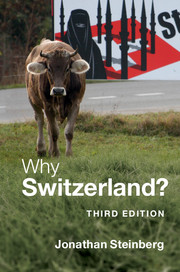7 - Why Italian Switzerland?
Published online by Cambridge University Press: 05 November 2015
Summary
The title of this chapter may seem frivolous when the entire book bears the title Why Switzerland? but it has a real significance in the overall conception of the work. If the plan is to show the distinctive features of Switzerland in its history, politics, linguistic and cultural diversity, wealth, relationship to Europe and ultimately to speculate on the nature of Swiss identity, then I believe that Italian Switzerland, and especially the Republic and Canton of Ticino, the Swiss canton whose only official language is Italian, (the Italian-speaking communities in Graubünden live in a tri-lingual canton) reveals that identity better than any other. Its uniqueness as the only Italian-speaking canton and the only large Swiss community on the southern slopes of the Alps marks a real difference between it and the other cantons.
I want to start the argument with a personal experience because it poses the question. When I began to work on the first edition of this book I had the good fortune to be the guest of the Pro Helvetia Stiftung, which arranged a trip to the four main linguistic regions. In April 1972 I found myself in Lugano on a Sunday with no appointments. The city had shut for the day. On a whim I took a train trip to Ponte Tresa, knowing nothing about it. There is a little train called just that, the trenino, which runs from Lugano to Ponte Tresa. In the bright April sun the little train rolled along stopping at Sorengo, Laghetto, Agnuzzo, Molinazzo and the rest of the little towns basking in the spring sunshine. I remember how Ponte Tresa on the Swiss side looked, its banks, shops, restaurants closed and sunshine glittering on the large glass windows. I walked across the bridge and there was Italy, noisy, open, messy, full of conversation, smells of espresso coffee and its kiosks overflowing with newsprint. I bought a Herald Tribune but there was no Corriere del Ticino nor Giornale del Popolo. Though the population of Ponte Tresa, Italy, lives off employment in Switzerland as frontalieri, one would never know it from external signs. I stood on the bridge between two worlds, the same people, the same dialects, the same economies but utterly different. Nor is this unique to the Italian-Swiss border.
- Type
- Chapter
- Information
- Why Switzerland? , pp. 243 - 281Publisher: Cambridge University PressPrint publication year: 2015



